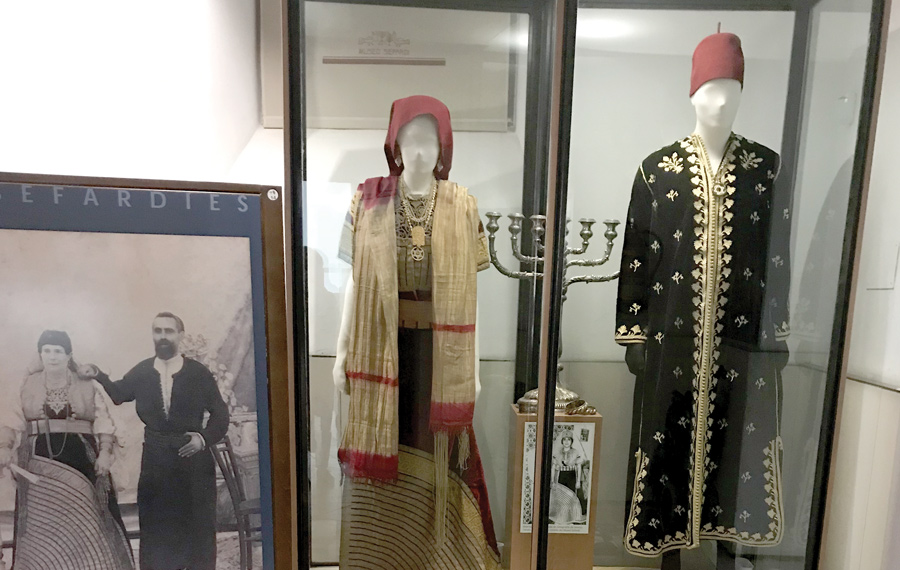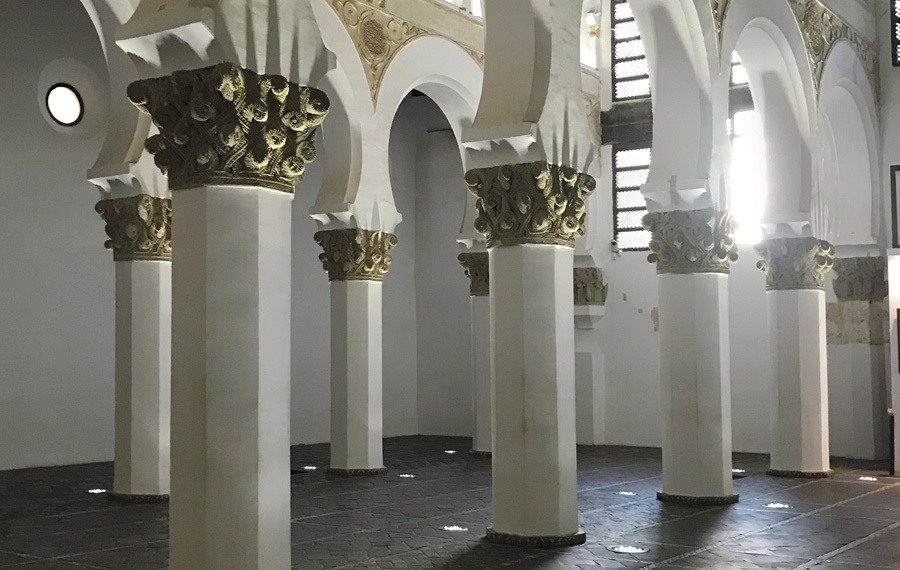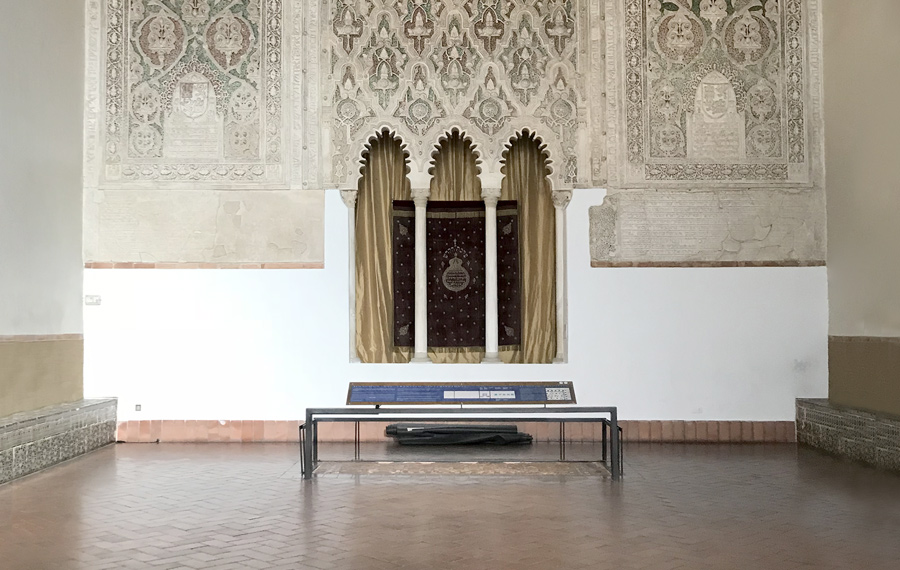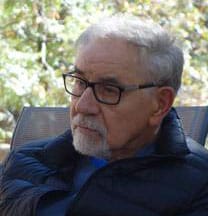 Sanctuary of Samuel Halevi
Abulafia
Synagogue, showing the ark and Hebrew inscriptions at the top.
Sanctuary of Samuel Halevi
Abulafia
Synagogue, showing the ark and Hebrew inscriptions at the top.
In the southwestern part of the walled city of Toledo, Spain, three large symbols are painted in the middle of the narrow street: a menorah, a Magen David and a chai. They mark the entrance to the Judería, Toledo’s Jewish Quarter, where more than 500 years ago, Jewish life, religion and culture flourished.
Inside the Quarter, some of the homes also display these symbols. Others have a tile that reads Sefarad (Spain), the letters artistically distorted in the shape of the country’s outline. It’s also the logo for Caminos de Sefarad, a tourism program launched by the Spanish government in 2012 that offers visitors a glimpse of Sephardic life in Spain in the 1400s.
I interviewed Spanish government officials when they came to Los Angeles in 2012 to promote the project. They said they hoped the initiative might help atone, in some small way, for the expulsion of Jews in 1492. More than six years after first hearing about Caminos de Sefarad, my wife and I visited Toledo’s Jewish Quarter this year.
Of the dozen or so synagogues that existed in pre-1492 Toledo, only two remain. Both are tourist sites. One is the Sinagoga El Tránsito, also known as the Synagogue of Samuel Halevi Abulafia, treasurer and adviser to King Pedro I. Built in 1356, it was attached to Halevi’s palatial home and was a private sanctuary for Halevi’s family and friends.
After the expulsion in 1492, the synagogue became a church, then later an archive for military records. Throughout these changes, the synagogue remained largely intact. In 1964, the Spanish government declared it “the most important Jewish site in Spain” and turned it into a museum, with the intention of showing how Sephardic Jews lived in Spain before 1492. It opened to the public in 1971 and is run by Spain’s Department of Culture and Sport.

The synagogue’s open hall leads to a Torah niche with three arches. The upper part of the hall is filled with intricate stucco decoration, including a lot of Hebrew script — prayers, snippets from the Bible and homages to King Pedro.
Jutting off from the open hall are small rooms containing the museum’s collection. Some items possibly belonged to Jews who lived in Toledo before 1492, but if you expect to see what life was like in the Jewish Quarter prior to the expulsion, you’re likely to be disappointed.
Rather than providing an immersive experience of Sephardic life in medieval Spain, the museum gives a surface glimpse of a group that is treated as if it no longer exists, like the Minoans or Hittites: This is how Sephardic Jews prayed. This is what they wore.
Many of the artifacts are typical religious objects: tallit, Torah keter, Torah yad, ketubah. The accompanying explanations seem aimed at people who know nothing about Judaism, not at Sephardic Jews trying to reconnect with their past. The explanations also are only in Spanish. For an English translation, you have to access the museum’s website on your phone.
“Spanish government officials said they hoped the Caminos de Sefarad tourism initiative in Toledo might help atone, in some small way, for the expulsion of Jews in 1492.”
One of the items on display is a facsimile of the actual 1492 expulsion order. The florid calligraphy of the original decree makes it hard to read, but there is a printed version of the text in Spanish. It’s a chilling document, bluntly warning Jews to leave the country or be killed.
An American tourist asked a guard why the museum isn’t managed by the Jewish community. He replied that it’s always been run by the government. Giving a former synagogue to the Jewish community is an idea that’s already come up in reference to Toledo’s other Jewish Quarter synagogue, Ibn Shoshan, built around 1180 and converted in 1411 into a church, Santa María la Blanca, which later became a monastery, then an armory. Now it’s in the hands of the Catholic Church. According to published reports, Isaac Querub, president of Spain’s Federation of Jewish Communities, has requested that the church turn over the property to the Jewish community as a gesture of good interfaith relations. The church has not yet responded to this request.
When we visited Santa María la Blanca, it was chilly and almost empty inside, but there was no hiding the synagogue’s stunning beauty. The interior has giant horseshoe arches decorated with delicate stucco motifs similar to those in the great Moorish edifices of Córdoba and Granada.
At the rear of the property is a gift shop featuring original artwork with mystical undertones. A Spanish woman in her 20s told us that the mystical artwork for sale was created by Abraham de la Cruz, a 76-year-old monk. The constantly repeated message of the artwork is that there should be brotherhood and love between the Catholic Church and Israel — both the country and the Jewish people.

I asked the young woman to tell us about De la Cruz.
“He was born with the name Abraham Kron in 1942 in France, to a Jewish family,” she said. “As a young man, he was an atheist. Then, when he was in his 30s, God entered his life and he converted to Catholicism. He was baptized and became Abraham de la Cruz. He came here to Spain and founded a monastic order called María Estrella de la Mañana (Mary, Star of the Morning.) His aim is to be a bridge between Catholics and Israel.”
So there we were, in Toledo’s Jewish Quarter, where Jews once lived but from which they were expelled more than 500 years ago, under penalty of death if they remained. Next to a strikingly beautiful 12th-century synagogue, the Catholic Church has permitted an enterprising Euro-mystical version of Jews for Jesus to sell paintings, drawings and books by a man who was born Jewish, then converted to Catholicism. It seemed, at the very least, tone-deaf on the part of the Spanish Church.
It made me wonder how serious the Spanish officials were who came up with Caminos de Sefarad as a means of reaching out to Jews and enticing them to come to Spain to see how modern Spain has made amends for its past sins.























 More news and opinions than at a Shabbat dinner, right in your inbox.
More news and opinions than at a Shabbat dinner, right in your inbox.